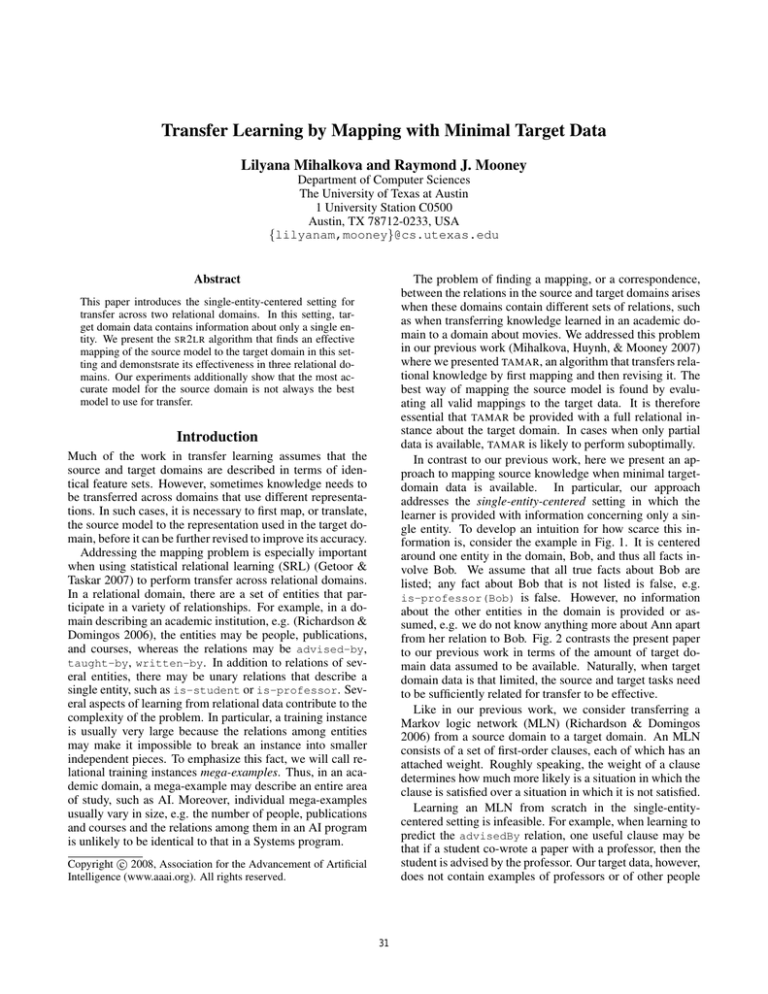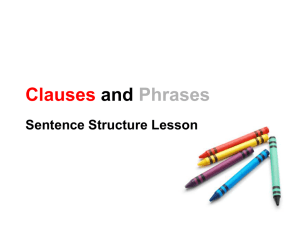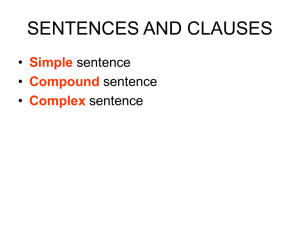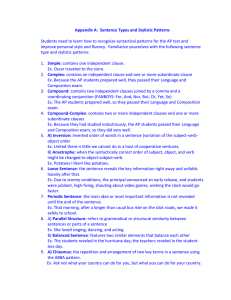
Transfer Learning by Mapping with Minimal Target Data
Lilyana Mihalkova and Raymond J. Mooney
Department of Computer Sciences
The University of Texas at Austin
1 University Station C0500
Austin, TX 78712-0233, USA
{lilyanam,mooney}@cs.utexas.edu
Abstract
The problem of finding a mapping, or a correspondence,
between the relations in the source and target domains arises
when these domains contain different sets of relations, such
as when transferring knowledge learned in an academic domain to a domain about movies. We addressed this problem
in our previous work (Mihalkova, Huynh, & Mooney 2007)
where we presented TAMAR, an algorithm that transfers relational knowledge by first mapping and then revising it. The
best way of mapping the source model is found by evaluating all valid mappings to the target data. It is therefore
essential that TAMAR be provided with a full relational instance about the target domain. In cases when only partial
data is available, TAMAR is likely to perform suboptimally.
In contrast to our previous work, here we present an approach to mapping source knowledge when minimal targetdomain data is available. In particular, our approach
addresses the single-entity-centered setting in which the
learner is provided with information concerning only a single entity. To develop an intuition for how scarce this information is, consider the example in Fig. 1. It is centered
around one entity in the domain, Bob, and thus all facts involve Bob. We assume that all true facts about Bob are
listed; any fact about Bob that is not listed is false, e.g.
is-professor(Bob) is false. However, no information
about the other entities in the domain is provided or assumed, e.g. we do not know anything more about Ann apart
from her relation to Bob. Fig. 2 contrasts the present paper
to our previous work in terms of the amount of target domain data assumed to be available. Naturally, when target
domain data is that limited, the source and target tasks need
to be sufficiently related for transfer to be effective.
Like in our previous work, we consider transferring a
Markov logic network (MLN) (Richardson & Domingos
2006) from a source domain to a target domain. An MLN
consists of a set of first-order clauses, each of which has an
attached weight. Roughly speaking, the weight of a clause
determines how much more likely is a situation in which the
clause is satisfied over a situation in which it is not satisfied.
Learning an MLN from scratch in the single-entitycentered setting is infeasible. For example, when learning to
predict the advisedBy relation, one useful clause may be
that if a student co-wrote a paper with a professor, then the
student is advised by the professor. Our target data, however,
does not contain examples of professors or of other people
This paper introduces the single-entity-centered setting for
transfer across two relational domains. In this setting, target domain data contains information about only a single entity. We present the SR 2 LR algorithm that finds an effective
mapping of the source model to the target domain in this setting and demonstsrate its effectiveness in three relational domains. Our experiments additionally show that the most accurate model for the source domain is not always the best
model to use for transfer.
Introduction
Much of the work in transfer learning assumes that the
source and target domains are described in terms of identical feature sets. However, sometimes knowledge needs to
be transferred across domains that use different representations. In such cases, it is necessary to first map, or translate,
the source model to the representation used in the target domain, before it can be further revised to improve its accuracy.
Addressing the mapping problem is especially important
when using statistical relational learning (SRL) (Getoor &
Taskar 2007) to perform transfer across relational domains.
In a relational domain, there are a set of entities that participate in a variety of relationships. For example, in a domain describing an academic institution, e.g. (Richardson &
Domingos 2006), the entities may be people, publications,
and courses, whereas the relations may be advised-by,
taught-by, written-by. In addition to relations of several entities, there may be unary relations that describe a
single entity, such as is-student or is-professor. Several aspects of learning from relational data contribute to the
complexity of the problem. In particular, a training instance
is usually very large because the relations among entities
may make it impossible to break an instance into smaller
independent pieces. To emphasize this fact, we will call relational training instances mega-examples. Thus, in an academic domain, a mega-example may describe an entire area
of study, such as AI. Moreover, individual mega-examples
usually vary in size, e.g. the number of people, publications
and courses and the relations among them in an AI program
is unlikely to be identical to that in a Systems program.
c 2008, Association for the Advancement of Artificial
Copyright Intelligence (www.aaai.org). All rights reserved.
31
is-student(Bob),
written-by(Paper1, Bob), written-by(Paper2, Bob)
advised-by(Bob, Ann)
used to translate the long-range clauses, thus boosting the
performance of the model in the target domain. We call our
new method Short-Range to Long-Range (SR 2 LR ).
Figure 1: Example target data provided to the learner.
Bob
...
...
Background
In first-order logic, a predicate represents a relation in the
domain, such as advised-by. Predicates can be viewed as
functions that return true or false in which each argument
has a type. For example, advised-by takes two arguments
of type person, whereas written-by takes an argument of
type paper and an argument of type person. An atom is a
predicate applied to terms, where the terms can be variables
or constants.1 Here, we will call constants entities. A (negative/positive) literal is an atom that (is/is not) negated. A
literal in which all terms are entities is ground. A fact is a
ground positive literal. A clause is a disjunction of literals.
A clause is ground if all of its literals are ground. The word
grounding refers to a ground literal or clause.
An MLN consists of a set of weighted formulae and provides a way of softening first-order logic by making situations in which not all clauses are satisfied less likely but
not impossible (Richardson & Domingos 2006). Let X
be the set of all propositions describing a world (i.e. all
ground literals in the domain), F be the set of all clauses
in the MLN, wi be the weight of clause fi , Gfi be the set
of all possible groundings of clause fi , and Z be the normalizing partition function. Then the probability of a particular truth assignment
P x to XPis given bythe formula
P (X = x) = Z1 exp
fi ∈F wi
g∈Gfi g(x) .
In our previous work (Mihalkova, Huynh, & Mooney
2007) we presented TAMAR, an algorithm that transfers
MLNs by mapping and revising them. We will review M TA MAR, the mapping portion of TAMAR, to which we will compare SR 2 LR . M TAMAR uses the concept of a type-consistent
mapping. In order to map a source clause to the target domain, one needs to map each predicate in the clause to a
predicate in the target domain. When mapping a source
predicate to a target predicate, one implicitly defines a mapping between the types of the arguments of the two predicates. A mapping is type-consistent if a type in the source
domain is mapped to at most one type in the target domain
over all predicate mappings within a clause. M TAMAR maps
each source clause independently of the others by evaluating all possible type-consistent mappings with the weighted
pseudo log-likelihood score introduced by Kok and Domingos (2005). This measure assumes that at least one full target
relational example is provided and uses the closed-world assumption to conclude that ground facts not listed as true in
the data are false.
Revising an MLN given only single-entity-centered target
data is infeasible. Therefore, we will not use the revision
portion of TAMAR, and SR 2 LR does not perform revision.
Paper1
.
Paper2
Ann
Cara
Dan
...
Paper3
...
Eve
written−by
advised−by
Figure 2: Target data available in previous versus current work.
The nodes in this graph represent the entities in the domain and the
edges represent the relations in which these entities participate. In
our previous work we assumed that the information from the entire
graph is available to the learner. In the present paper, we assume
that only the bold relations are known.
who wrote papers and thus this clause cannot be learned.
Therefore, applying transfer learning to this setting is a natural approach to take. In fact, it seems to be the approach
taken by people when they relate their previous experiences
to a new environment. Consider, for instance, a situation
in which an actor A, who is intimately familiar with the
workings of the movie business but has never been to college, first encounters the academic world by meeting a single
representative from academia, professor P. Professor P talks
about the graduate students she advises, the publications she
has written, and the courses she has taught. This information, which is entirely centered on a single individual from
academia, will be sufficient for actor A to form a fairly accurate idea of how the academic world works. He may imagine
that advising a student is similar to instructing an actor when
directing a movie, thus drawing an analogy between professors and movie directors, between actors and students, and
between publications and movies. From this, actor A may
further conclude that professor P’s students are also listed
in the “credits” of some of her publications, thus drawing
conclusions about entities (i.e. the students) of which he has
never seen examples.
Our algorithm is based on the observation that a good
model for the source domain contains two types of clauses—
short-range ones that concern the properties of a single entity
and long-range ones that relate the properties of several entities. Because possible translations of the short-range clauses
to the target domain can be evaluated on the available targetdomain data, the key is to use the short-range clauses in order to find meaningful correspondences between the relations in the two domains. These correspondences are then
Our Approach
This section describes the SR 2 LR algorithm. SR 2 LR is designed for the case when target-domain data is available only
1
32
We assume the domains contain no logical functions.
1.1 advised-by(a, b) ⇒ ¬is-professor(a)
1.2 advised-by(a, b) ⇒ ¬is-student(a)
2.1 written-by(m, a) ∧ written-by(m, b) ∧ is-professor(b)
⇒ advised-by(a, b)
2.2 written-by(m, a) ∧ written-by(m, b) ∧ is-student(b)
⇒ advised-by(a, b)
worked-for → advised-by, is-director → is-professor
worked-for → advised-by, is-director → is-student
worked-for → advised-by, is-director → is-professor, in-movie → written-by
worked-for → advised-by, is-director → is-student, in-movie → written-by
Table 1: Example mapped clauses with predicate correspondences
0.7 : worked-for(a, b) ⇒ ¬is-director(a)
0.8 : in-movie(m, a) ∧ in-movie(m, b) ∧ is-director(b)
⇒ worked-for(a, b)
in the form of a single-entity-centered example.
Definition 1 A training example is single-entity-centered
with respect to an entity E if it lists all the true facts involving E, and only those facts. Facts that involve E but are not
listed are assumed to be false. Facts that do not involve E
have unknown truth values. E is called the central entity.
SR 2 LR starts by producing all possible type-consistent
mappings of the clauses in the source model. Typeconsistent mappings are defined in the Background section.
As we discussed in that section, a mapping from a source
clause to the target domain implies a correspondence from
the source predicates that appear in the source clause to
a subset of the target predicates. M TAMAR evaluates the
usefulness of this correspondence by measuring the performance of the mapped clause in the target domain based on
a probabilistic score. In the single-entity-centered setting,
however, not all mapped clauses can be evaluated in this
way because the target data is incomplete. The key idea of
SR 2 LR is to find valid source-to-target predicate correspondences by directly evaluating only the clauses whose performance can be measured on the available data and then to
use these correspondences to produce mappings for clauses
whose performance cannot be directly measured in the target domain. Mapped clauses that can be directly evaluated
are called short-range; the rest are called long-range.
Figure 3: Source MLN from toy movie domain
Algorithm 1 SR 2 LR algorithm
Input:
1: SM: Source Markov logic network
2: TE : Single-entity-centered target data
3: E: Central entity
4: P: Set of predicates in the target domain
5: Θ: Truth threshold for accepting a short-range clause
Output:
6: Result: Markov logic network for the target domain
Procedure:
7: Generate TM, the set of all possible type-consistent mappings
of the clauses in SM. Each mapped clause is given the weight
of its corresponding source clause.
8: Split the clauses in TM into sets S of short-range clauses and L
of long-range clauses.
9: S′ = filter-short-range(S, Θ)
10: Add all clauses from S′ to Result
11: L ′ = filter-long-range(L, S′ )
12: Add all clauses from L ′ to Result
13: Let A C be the set of all clauses in Result mapped from source
clause C with weight wC .
14: Set the weight of each a ∈ A C to wC /|A C |.
Definition 2 A clause C is short-range with respect to an
entity of type t iff there exists a variable v that appears in
every literal of C and v represents arguments of type t. We
call any such variable v pivotal.
tions 2 and 3, this clause is long-range. An intuitive interpretation is that this clause concerns relations that go beyond
just a single entity, e.g. about papers written by other people.
Definition 3 A clause is long-range with respect to E iff it
is not short-range.
As an example, suppose we would like to transfer the
MLN in Fig. 3 using the data in Fig. 1, i.e. transfer from
a toy movie domain to a toy academic domain. Let us
consider one possible type-consistent mapping of the first
clause, given in line 1.1 of Table 1. Note that if we ground
this clause using the substitution a = Bob, b = Ann, we obtain a ground clause whose literals are all known from our
data, thus the clause can be evaluated and hence, it is shortrange. If we use the substitution a = Ann, b = Bob, the
resulting grounding cannot be evaluated because the truthvalue of is-professor(Ann) is unknown. We say that
the first grounding is verifiable, whereas the second is not.
Algorithm 1 formally lists the steps SR 2 LR takes. In
line 9, the short-range mapped clauses are evaluated, as described in Algorithm 2. Because of the restricted nature of
the available target data, rather than using a probabilistic
measure, we simply check whether the verifiable groundings of short-range clauses are satisfied on the target data.
Clauses that are satisfied at least Θ proportion of time are
accepted; the rest are rejected. This procedure automatically
rejects clauses that are not informative, as defined next.
Definition 5 A short-range clause is informative with respect to a single-entity-centered example if it has a verifiable
grounding in which at least one ground literal is false.
For example, consider the clause is-student(a) ∨
¬advised-by(b, a). This clause has two verifiable groundings corresponding to the substitutions a = Bob, b =
Ann, and a = Bob, b = Bob. It is not informative because all the literals in its verifiable ground-
Definition 4 A ground short-range clause is verifiable on
a single-entity-centered example if a pivotal variable is replaced by the central entity.
Now consider one possible mapping of the second clause
in Fig. 3, given in line 2.1 of Table 1. According to defini-
33
Algorithm 2 filter-short-range(S, Θ)
Algorithm 3 filter-long-range(L, S′ )
′
1: S = ∅
2: for each C ∈ S do
3:
if C is informative then
4:
if The proportion of verifiable groundings of C that are
true is ≥ Θ then
5:
Add C to S′
6:
end if
7:
end if
8: end for
9: Return S′
1: L ′ = ∅
2: for each LR ∈ L do
3:
for each SR ∈ S′ do
4:
if SR supports LR then
5:
Mark the corresponding literals in LR as “supported”
6:
end if
7:
end for
8:
if All literals in C are supported then
9:
Add C to L ′
10:
else if All unsupported literals are supported by exclusion
wrt S′ then
11:
Add C to L ′
12:
end if
13: end for
14: Return L ′
ings, i.e. is-student(Bob), ¬advised-by(Ann, Bob)
and ¬advised-by(Bob, Bob), are true. To develop an
intuition for the significance of definition 5, consider
one of the verifiable groundings: is-student(Bob) ∨
¬advised-by(Ann, Bob).
We can re-write it as
¬is-student(Bob) ⇒ ¬advised-by(Ann, Bob) or as
advised-by(Ann, Bob) ⇒ is-student(Bob). Thus
clauses that are not informative cannot be used to draw inferences, i.e. they are always trivially satisfied because their
preconditions do not hold. Therefore, judgements about
predicate mappings based on clauses that are not informative are likely to be misleading.
Once the short-range clauses are evaluated, in line 11
of the main algorithm, SR 2 LR evaluates the long-range
ones, based on the source-to-target predicate correspondences found to be useful for short-range clauses. Algorithm 3 uses the following definitions.
Definition 6 Let CS and CL be short-range and long-range
mapped clauses respectively. If the set of source-to-target
predicate correspondences implied by CS is a subset of
those implied by CL , we say that CS supports CL . The
literals of predicates in CL that also appear in CS are said
to be supported.
Definition 7 A correspondence between source predicate
PS and target predicate PT is supported by exclusion with
respect to a set of mapped short-range clauses S′ if PS and
PT do not appear in any of the source-to-target predicate
correspondences implied by the clauses in S′ .
The goal of support by exclusion is to allow for predicates that do not appear in the short-range source clauses to
be mapped. Even though support by exclusion may seem too
risky in the sense that a pair of completely unrelated source
and target predicates may be mapped to each other, in our
experience the type consistency constraint and the requirement that neither of the predicates was mapped to any other
predicate were strong enough to safeguard against this.
We now illustrate the operation of Algorithm 1 up to line
13. Table 1 lists some of the possible ways of mapping the
clauses in Fig. 3, along with the source-to-target predicate
correspondences implied by them. Clauses 1.* in are (informative) short-range, while 2.* are long-range. Let Θ = 1.
All verifiable groundings of clause 1.1 are satisfied by the
target data. Thus, this clause is accepted in the resulting
model and the predicate correspondences found by it are
useful. Clause 1.2 is rejected because not all of its groundings are satisfied by the target data. Thus the set S′ contains
only clause 1.1. Moving on to the long-range clauses, we see
that predicates advised-by and is-professor in clause
2.1 are supported by clause 1.1; written-by is supported
by exclusion, so clause 2.1 is accepted. Clause 2.2 cannot be
accepted because there is no support for is-student(b).
Finally, in lines 13-14 of Algorithm 1 the weight of each
mapped clause MC is divided by the number of mapped
clauses that originated from the same source clause as MC
in order to ensure that none of the source clauses dominates
the resulting model. We found that performing the weight
adjustment led to better performance. These experimental
results are omitted because of space considerations.
Experiments
We compared SR 2 LR to M TAMAR on the three domains
we used previously (Mihalkova, Huynh, & Mooney 2007):
IMDB, UW-CSE, and WebKb,2 treating each possible ordered pair of them as a source and a target. WebKb and
UW-CSE are about academics. IMDB is about movies.
UW-CSE contains the predicates taughtBy, courseLevel, position, advisedBy, projectMember, phase, tempAdvisedBy,
yearsInProgram, TA ,student, professor, samePerson, sameCourse, sameProject, publication; IMDB the predicates director, actor, movie, gender, workedUnder, genre, samePerson, sameMovie, sameGenre, sameGender; and WebKB the
predicates student, faculty, project, courseTA, courseProf.
Although some predicates have the same names in different
domains, predicate names are not used by either system.
We used two sets of source MLNs. The first set was
learned using BUSL (Mihalkova & Mooney 2007); the second set was learned using a relaxed version of BUSL that
learns models that are less accurate in the source domain but
contain more clauses. The relaxed set of sources was motivated by the hypothesis that the best-performing model in
the source domain is not necessarily the best model to use
for transfer. We also experimented with using the manually developed knowledge base provided with UW-CSE as a
source (we call this hand in our experiments). We removed
2
UW-CSE is available from http://alchemy.cs.
washington.edu/. IMDB and WebKb are available from
http://www.cs.utexas.edu/users/ml/mlns/
34
from UW-CSE busl from UW-CSE relaxed from UW-CSE hand
mTamar SR 2 LR mTamar
SR 2 LR
mTamar SR 2 LR
director
0.95
0.95
1.00
1.00
0.59
0.61
actor
0.53
0.91
1.00
1.00
0.98
0.95
movie
0.12
0.15
0.22
0.28
0.23
0.31
gender
0.24
0.46
0.33
0.45
0.37
0.54
workedUnder 0.03
0.01
0.04
0.39
0.51
0.94
genre
0.02
0.02
0.03
0.01
0.44
0.54
sameMovie 0.08
0.12
0.09
0.12
0.08
0.12
sameGenre 0.05
0.07
0.06
0.08
0.06
0.07
sameGender 0.11
0.25
0.14
0.58
0.11
0.25
from Webkb busl from Webkb relaxed
mTamar SR 2 LR mTamar SR 2 LR
director
0.95
0.99
0.63
0.74
movie
0.22
0.28
0.22
0.28
gender
0.17
0.26
0.17
0.26
samePerson 0.90
0.90
0.90
1.00
sameMovie 0.08
0.12
0.08
0.12
sameGenre 0.05
0.07
0.05
0.07
sameGender 0.11
0.25
0.11
0.25
Table 2: AUC for transfer to IMDB. Bold results are significantly better than the performance of M TAMAR given the same source.
in UW-CSE. Thus, this demonstrates that SR 2 LR is capable of discovering useful predicate correspondences. When
transferring from a domain with a richer predicate set to one
with fewer predicates, there invariably will be target predicates to which no useful correspondences were found. This
explains the more modest performance gains observed when
transferring to UW-CSE or from WebKb. Because WebKb
has the smallest number of predicates, which seem to have
obvious correspondences to predicates in UW-CSE, it may
seem surprising that we do not observe bigger performance
gains in transfer to WebKb. This behavior can be explained
if we look more closely at the WebKb predicates where performance is especially poor: courseTA(coursename, person)
and courseProf(coursename,person). Their obvious counterparts in UW-CSE are TA(course, person, semester) and
taughtBy(course, person, semester). As we see, the UWCSE predicates have arity 3, whereas the WebKb ones have
arity 2. At present, SR 2 LR maps only predicates with the
same arity to each other; in the future we plan to experiment
with less restrictive clause-mapping techniques.
To answer the second question, we observe that transfer from the “relaxed” sources can give better results, even
though the “busl” sources perform much better in the source
domains. This demonstrates that the best model in the
source domain is not necessarily the best one for transfer. In
the single-entity-centered scenario, sources that have more
short-range clauses lead to better results.
from this knowledge base all clauses that refer to specific
entities in UW-CSE because SR 2 LR and M TAMAR do not
map entities. We used generative weight-training to learn
weights for the clauses in the knowledge base in the source
domain (Richardson & Domingos 2006). Target training
data in each case consisted of a single-entity-centered example, where the central entity was one of the entities of
type person in the domain. In IMDB, the average size of a
training example was 6.26 true ground facts; in UW-CSE it
was 10.40, and in Webkb it was 2.66. The size of the full
mega-example in IMDB was 320 true ground facts; in UWCSE 766 true ground facts, and in WebKb 519 true ground
facts. We report average performances over all entities of
type person in each domain.
We evaluated the performance of the mapped MLNs by
performing leave-one-predicate-out inference over them in
the full mega-example, as done in previous work (Kok &
Domingos 2005; Mihalkova, Huynh, & Mooney 2007). For
inference we used MC-SAT (Poon & Domingos 2006). The
results are reported in terms of the area under the precisionrecall curve (AUC). This measure is particularly appropriate
for relational domains because it focuses on how well the
algorithm predicts the few true positives and is not misled
by the large number of true negatives in the data.
We implemented SR 2 LR as part of the Alchemy package (Kok et al. 2005), and used the implementation of
M TAMAR available at http://www.cs.utexas.edu/
users/ml/mlns/. We set Θ = 1.
Related Work
Results
The problem of mapping a source model to a target domain has also been addressed by others. For example, the
Structure-Mapping Engine (Falkenhainer, Forbus, & Gentner 1989) uses reasoning by analogy to find correspondences between source and target predicates. In the area
of reinforcement learning, Taylor et al. (2008) present a
method for mapping the feature spaces across tasks by using samples from runs in the two tasks.
Our work is also related to the problem of transfer learning within the SRL setting. Guestrin et al. (2003) use a
relational representation as a vehicle to achieving transfer
by learning general rules about the ways objects interact.
Recently, Deshpande et al. (2007) presented a hierarchical
Bayesian approach to transferring knowledge about probabilistic planning rules. Torrey et al. (2007) use SRL tech-
Our experiments address the following questions:
1. In which cases does SR 2 LR outperform M TAMAR?
2. How does the choice of source model affect performance?
To answer the first question, in Tables 2-4, we report the performance of the systems for predicting each predicate separately. We only show the predicates for which M TAMAR performs better than SR 2 LR or for which SR 2 LR is significantly
better than M TAMAR. Statistical significance was measured
using a paired t-test at the 95% confidence level. Predicates
for which SR 2 LR performs at least as well as M TAMAR but
the difference is not significant are omitted to save space.
SR 2 LR achieves the greatest performance gains in the
UW-CSE → IMDB experiment. This is not surprising because each predicate in IMDB has a corresponding predicate
35
courseLevel
position
advisedBy
phase
yearsInProgram
student
professor
samePerson
sameCourse
publication
from IMDB busl
mTamar SR 2 LR
0.33
0.25
0.20
0.36
0.02
0.02
0.20
0.28
0.03
0.09
0.87
0.89
0.41
0.30
0.02
0.01
0.02
0.02
0.02
0.02
from IMDB relaxed
mTamar
SR 2 LR
0.24
0.25
0.05
0.31
0.01
0.03
0.15
0.28
0.05
0.09
0.78
0.95
0.32
0.92
0.01
0.01
0.03
0.02
0.03
0.02
courseLevel
phase
student
professor
samePerson
publication
from Webkb busl
mTamar SR 2 LR
0.16
0.25
0.09
0.12
0.98
0.95
0.93
0.79
0.52
0.67
0.02
0.06
from Webkb relaxed
mTamar
SR 2 LR
0.16
0.25
0.09
0.12
0.95
0.77
0.64
0.41
0.68
0.94
0.04
0.03
Table 3: AUC for transfer to UW-CSE. Bold results are significantly better than the performance of M TAMAR given the same source.
from IMDB busl from IMDB relaxed
mTamar SR 2 LR mTamar SR 2 LR
student 0.46
0.67
0.46
0.67
faculty 0.21
0.15
0.21
0.15
project 0.02
0.01
0.03
0.01
from UW-CSE hand from UW-CSE busl from UW-CSE relaxed
mTamar SR 2 LR mTamar SR 2 LR mTamar
SR 2 LR
student 0.91
0.80
0.38
0.76
0.98
0.99
faculty 0.35
0.66
0.12
0.24
0.96
0.98
Table 4: AUC for transfer to Webkb. Bold results are significantly better than the performance of M TAMAR given the same source.
as necessarily representing the official policies, either expressed or implied of DARPA, AFRL, Microsoft, or the
United States Government. The experiments were run on the
Mastodon Cluster, provided by NSF Grant EIA-0303609.
niques to learn relational macros in the source task that then
guide the initial stages of learning in the target task.
None of this previous work, however, addresses the
single-entity-centered setting.
Conclusion and Future Work
References
This paper introduces the single-entity-centered setting of
transfer in which data about only one entity in the target
domain is available. We presented the SR 2 LR algorithm
which evaluates possible source-to-target predicate correspondences based on short-range clauses in order to also
transfer the knowledge captured in long-range clauses.
The single-entity-centered setting can be viewed as one
extreme on the spectrum of possible available relational
data. On the other end of the spectrum is a full megaexample. In the future, we plan to study how the relative
performance of SR 2 LR and M TAMAR changes as data about
an increasing number of entities becomes available. We also
plan to experiment with novel ways of mapping a source
clause to the target domain. At present, we require that a
source predicate be mapped to a single target predicate of
the same arity, and we map the arguments of the predicates
in order. We would like to consider mappings in which different arity predicates are mapped to each other by using
techniques such as merging their arguments, as well as mappings in which the arguments are mapped in different orders.
Finally, we would like to explore ways of mapping a conjunction of two source predicates to a single target predicate
and vice versa, thus performing a sort of transfer-motivated
predicate invention.
Deshpande, A.; Milch, B.; Zettlemoyer, L. S.; and Kaelbling,
L. P. 2007. Learning probabilistic relational dynamics for multiple tasks. UAI-07.
Falkenhainer, B.; Forbus, K. D.; and Gentner, D. 1989. The
structure-mapping engine: Algorithm and examples. Artificial
Intelligence 41(1):1–63.
Getoor, L., and Taskar, B., eds. 2007. Introduction to Statistical
Relational Learning. MIT Press.
Guestrin, C.; Koller, D.; Gearhart, C.; and Kanodia, N. 2003.
Generalizing plans to new environments in relational MDPs.
IJCAI-03.
Kok, S., and Domingos, P. 2005. Learning the structure of
Markov logic networks. ICML-05.
Kok, S.; Singla, P.; Richardson, M.; and Domingos, P. 2005.
The Alchemy system for statistical relational AI. Tech. report,
Dept. of Comp. Sci. and Eng., University of Washington. http:
//www.cs.washington.edu/ai/alchemy.
Mihalkova, L., and Mooney, R. J. 2007. Bottom-up learning of
Markov logic network structure. ICML-07.
Mihalkova, L.; Huynh, T.; and Mooney, R. J. 2007. Mapping and
revising Markov logic networks for transfer learning. AAAI-07.
Poon, H., and Domingos, P. 2006. Sound and efficient inference
with probabilistic and deterministic dependencies. AAAI-06,
Richardson, M., and Domingos, P. 2006. Markov logic networks.
Machine Learning 62:107–136.
Taylor, M. E.; Kuhlmann, G.; and Stone, P. 2008. Autonomous
transfer for reinforcement learning. AAMAS-08.
Torrey, L.; Shavlik, J.; Walker, T.; and Maclin, R. 2007. Relational macros for transfer in reinforcement learning. ILP-07.
Acknowledgement
This work is partially supported by DARPA grant FA875005-2-0283 (managed by AFRL) and by a research gift from
Microsoft.The views and conclusions contained in this document are those of the authors and should not be interpreted
36









